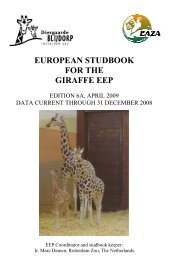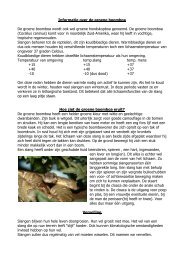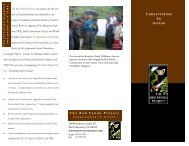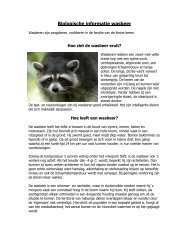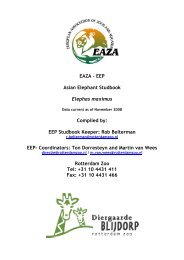Create successful ePaper yourself
Turn your PDF publications into a flip-book with our unique Google optimized e-Paper software.
<strong>EEP</strong> STUDBOOK CROWNED PIGEONS<br />
6.4 Comparison in time-budgets between crowned <strong>pigeon</strong>s<br />
kept under different housing conditions<br />
Introduction<br />
Because of the fast growth of the human population, the increase of tourism and the rapid<br />
growth of the <strong>number</strong> of industries, the undisturbed part of the island of New Guinea is<br />
declining quickly. Because crowned <strong>pigeon</strong>s are an easy prey to hunters, they disappear<br />
everywhere where humans occur. Because remote areas are disappearing very rapidly the<br />
<strong>number</strong> of crowned <strong>pigeon</strong>s in the wild is declining just as fast. Now the <strong>number</strong>s are<br />
declining very quickly, conservation institutions feel the urge to establish a sustainable<br />
population in captivity. Because of the negative natural growth of the population, research is<br />
continuously carried out into different aspects of the ex situ husbandry.<br />
The most important problem is the low birth rate in captivity. Data from zoological<br />
collections show that crowned <strong>pigeon</strong>s must be able to produce and raise three clutches a year<br />
in captivity and that they are able to produce fertile eggs for over twenty years. At first sight it<br />
should be easy to maintain a stable population in captivity (Nijboer and King, 1996).<br />
Unfortunately, the current situation is not prosperous and for that reason the <strong>EEP</strong> Speciescommittee<br />
proposed an ex situ research project into the wellbeing and reproduction of<br />
crowned <strong>pigeon</strong>s in captivity.<br />
The main problem is the big loss of eggs and squabs, as a result of a lot of infertilized eggs.<br />
Furthermore a lot of embryos are dying during incubation. Also a lot of eggs are demolished<br />
or thrown out of the nest. Only one out of six eggs will finally deliver a new mature crowned<br />
<strong>pigeon</strong> (Nijboer and King, 1996). Many scientists advice to conduct research into the<br />
accessibility of the nest and the care of the parents for the squab (King, Nijboer and Wiersma,<br />
1996; King and Nijboer, 1996). Some of them also state it is important to conduct research<br />
into the fact that only a low <strong>number</strong> of crowned <strong>pigeon</strong>s are producing eggs (King and<br />
Nijboer, 1996). Apart from this the condition of the toes of most crowned <strong>pigeon</strong>s seems not<br />
to be very well. In most cases the nails are too long or the birds are not able to bow their toes<br />
(King, pers. comm.). As a consequence, it is likely that the males have problems to copulate,<br />
because they are not able to hold the hen. This should reduce the chance of a successful<br />
mating. It might be possible to improve the condition of the feet by changing the thickness of<br />
the perches and by using a different kind of substrate.<br />
The target of the research project in zoos was to improve the wellbeing of crowned <strong>pigeon</strong>s in<br />
captivity by improving the reproduction of crowned <strong>pigeon</strong>s ex situ. To reach that goal the<br />
following research questions were formulated:<br />
� What is the time budget of crowned <strong>pigeon</strong>s under different circumstances/housing<br />
Guinea conditions?<br />
� Do the perches influence the well being of them and, as a consequence of that, the<br />
reproduction of crowned <strong>pigeon</strong>s?<br />
� Does the substrate have any influence on the time budget of crowned <strong>pigeon</strong>s?<br />
97



